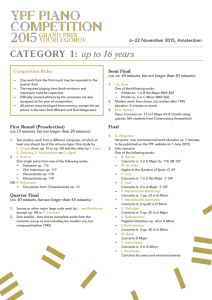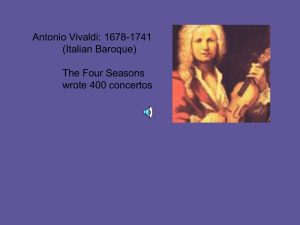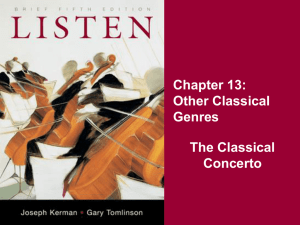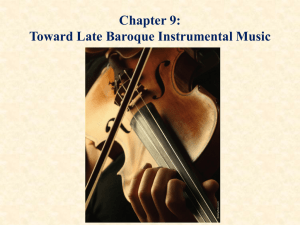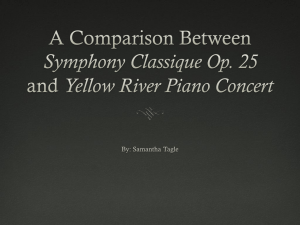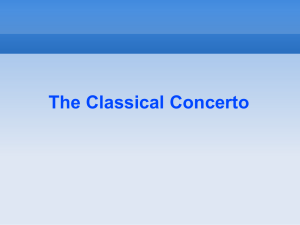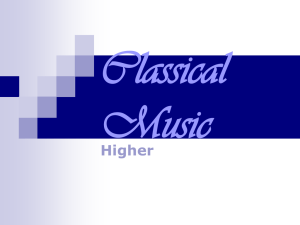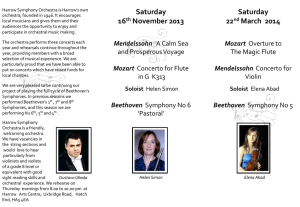Died March 28, 1943 in Beverly Hills
advertisement
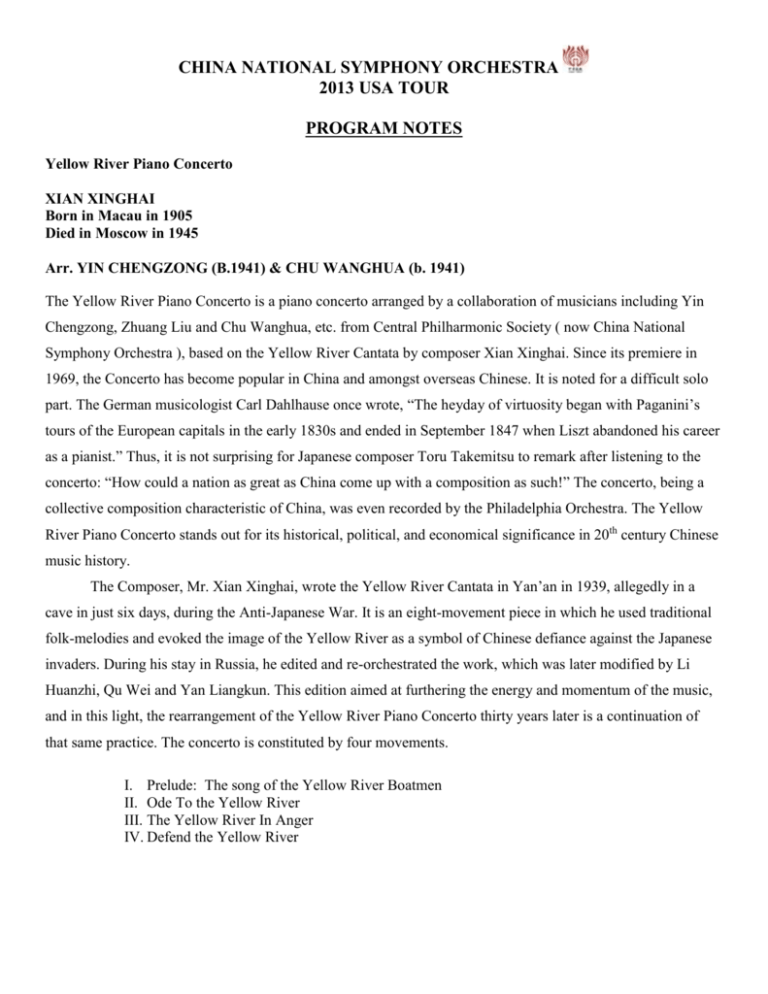
CHINA NATIONAL SYMPHONY ORCHESTRA 2013 USA TOUR PROGRAM NOTES Yellow River Piano Concerto XIAN XINGHAI Born in Macau in 1905 Died in Moscow in 1945 Arr. YIN CHENGZONG (B.1941) & CHU WANGHUA (b. 1941) The Yellow River Piano Concerto is a piano concerto arranged by a collaboration of musicians including Yin Chengzong, Zhuang Liu and Chu Wanghua, etc. from Central Philharmonic Society ( now China National Symphony Orchestra ), based on the Yellow River Cantata by composer Xian Xinghai. Since its premiere in 1969, the Concerto has become popular in China and amongst overseas Chinese. It is noted for a difficult solo part. The German musicologist Carl Dahlhause once wrote, “The heyday of virtuosity began with Paganini’s tours of the European capitals in the early 1830s and ended in September 1847 when Liszt abandoned his career as a pianist.” Thus, it is not surprising for Japanese composer Toru Takemitsu to remark after listening to the concerto: “How could a nation as great as China come up with a composition as such!” The concerto, being a collective composition characteristic of China, was even recorded by the Philadelphia Orchestra. The Yellow River Piano Concerto stands out for its historical, political, and economical significance in 20th century Chinese music history. The Composer, Mr. Xian Xinghai, wrote the Yellow River Cantata in Yan’an in 1939, allegedly in a cave in just six days, during the Anti-Japanese War. It is an eight-movement piece in which he used traditional folk-melodies and evoked the image of the Yellow River as a symbol of Chinese defiance against the Japanese invaders. During his stay in Russia, he edited and re-orchestrated the work, which was later modified by Li Huanzhi, Qu Wei and Yan Liangkun. This edition aimed at furthering the energy and momentum of the music, and in this light, the rearrangement of the Yellow River Piano Concerto thirty years later is a continuation of that same practice. The concerto is constituted by four movements. I. Prelude: The song of the Yellow River Boatmen II. Ode To the Yellow River III. The Yellow River In Anger IV. Defend the Yellow River The Butterfly Lovers’ Violin Concerto GANG CHEN Born 1935 in Shanghai, China ZHANHAO HE Born 1933 in Zhuji, China The Butterfly Lovers’ Violin Concerto takes its inspiration from the Chinese folk legend “Liang Zhu,” short for “The Love Story of Liang Shanbo and Zhu Yingtai.” It is a one-movement concerto, making use of some tunes from the Yu Theatre (or Zhejiang Opera), and is programmatic in nature. The concerto is divided into three main sections, respectively based upon the three main episodes of the Liang Zhu story, namely the First Meeting, Resistance to an Arranged Marriage, and Transformation into Butterflies. The three sections also correspond to the classical sonata form’s exposition, development, and recapitulation. The Butterfly Lovers’ Violin Concerto is one of the most famous works of Chinese music and certainly one of the most famous outside of China. It is an orchestral adaptation of the ancient legend, The Butterfly Lovers. Written for a western style orchestra, it features a solo violin played using some Chinese techniques. The Butterfly Lovers’ Violin Concerto was written in 1959 by two Chinese composers, Chen Gang and He Zhanhao, while they were students at the Shanghai Conservatory of Music. He Zhanhao is more widely credited for the composition of the concerto. However, his main contribution was the famous opening theme, while most of the development was in fact written by Chen Gang. The debut of the Butterfly Lovers’ Violin Concerto was performed by Yu Lina at the age of 18 in Shanghai as part of the celebration of the 10th anniversary of the founding of the People’s Republic of China. Along with Yu Lina, one of the first violinists who made a recording of this concerto was Shen Rong with Symphony Orchestra of Shanghai Music Conservatory. The Butterfly Lovers’ Violin Concerto is written in a traditional 5-note technique (pentatonic scale). It uses many Chinese melodies, chord structures and patterns. The Concerto is in one movement, but broken into distinct sections. Each tells a different part of the story of The Butterfly Lovers. Some of the melodies come from the Chinese Opera of the same name or from traditional Chinese folk songs. The solo violin of the concerto is symbolic of Zhu Yingtai, the story’s protagonist, and the cello part is symbolic of Liang Shanbo, her lover. The Concerto begins with a flute and then enters into a simple melody played by the solo violinist. The melody comes from a Chinese folk song of the yellow river, and tells the story of Zhu Yingtai’s student period. The Solo violin is accompanied by a harp and other elements of the orchestra. When both the students must return home, Zhu invites Liang Shanbo to visit her family and to court her sister. Liang doesn’t know that Zhu is really inviting him to marry her. Liang promises to see Zhu again, but Liang waits before doing so. When Liang finally arrives, he sees Zhu and realizes that she is a woman, and they fall in love. The solo violin and cello parts play a sad duet that is the most famous and powerful of the work. The love duet between the two is replaced by anger as Liang learns that in his absence, Zhu has been betrothed to another by her father. The two solo parts contrast the rest of the orchestra. Several melodies are used in this section, the orchestra plays loud and accented chords in between the softer cello and violin parts and the parts are often intertwined. Liang becomes sick and dies as the music replays the duet of their love. Zhu and the orchestra continue to play their contrasting parts. The section ends with the suicide of Zhu Yingtai as the solo violin plays an overarching high note. The lovers’ parts are overcome by a final orchestral section. In the legend, Liang’s grave opens and Zhu throws herself into the chasm. The music and story have a beautiful choreography of dramatic ballet that will be toured to the United States of America by Shanghai Ballet in fall of 2013. Violin Concerto in D minor, Op. 47 JEAN SIBELIUS Born December 8, 1865, in Hämeenlinna (Tavastehus) Died September 20, 1957, in Järvenpää Early in his life Sibelius manifested an interest in music; he actually began composing before having received any instruction in music theory. After studying piano and violin, he made a definite decision in his twentieth year to become a composer. He studied in Helsinki and later in Berlin, returning to Finland in 1899. It was at this time that he received a monetary grant from the Finnish state that enabled him to devote his entire creative endeavors to composition. Having styled himself "a dreamer and poet of nature," Sibelius came to carve for himself a special place in the development of Scandinavian music, with his native Finland dominating the genre. His works reveal a close identity with Finnish nationalism and his inspiration often came from Norse mythology and the Scandinavian naturalist poets. Indeed, one would be hard pressed to find one of his work that is not characterized by the typical "Sibelius sound," where scenery and deed alternate in shifting blends of tone, often combining the qualities of picture and story. Just like the symphonies and the tone poems may strike the listener as containing great canvases of Finland's landscape and heroic past, the Violin Concerto seems to be tinged by a mood of communion with nature. Remarks about this work from music analysts and commentators include such ones as: "bardic songs heard against a background of pagan fires in some wild Northern night;" "the settled melancholy of a Finland of Northern darkness;" and "the violin expresses...the labor and the love of a sensitive, almost morbidly modern, personality among the crude and prehistoric conditions of an unprotected land and ancient myths." Sibelius wrote the Violin Concerto at Lojo, Finland, in 1903; it was premiered on February 8, 1904, under the composer's direction, with Victor Novacek as the soloist. Sibelius then revised the work during the summer of 1905 and in this new, definitive version it was first performed in Berlin on October 19, 1905, with Karl Halir playing the violin under the direction of Richard Strauss. By virtue of its thematic material and the way in which it is developed, Sibelius' only concerto stands alongside his symphonies and tone poems as testament to the composer's right of inclusion in the list of the great European composers of the twentieth century. Music writer Louis Biancoli best summarizes the make-up of this work in the following words: "Despite its strongly modern character and modified sonata form, Sibelius' score belongs to the romantic tradition of the nineteenth century concerto. The so-called 'bardic' moods and exotic folk like strains give it a special salience of its own. The opposition of violin and orchestra is almost unique in its brooding contrasts, and the rhapsodic note of remote minstrelsy is strong, especially in the first movement. But the technique, the mounting climaxes, the surging drama of tone and theme, the high-register flutterings all give it a kinship with other repertory of the later romantic period." The first movement is in a free sonata form. The solo violin announces the principal theme over divided and muted strings, the somber character accentuated by an imitation of the opening motif by a clarinet. Two more important themes follow and, after a cadenza for the solo, the three subjects are recapitulated and developed at the same time. The Adagio di molto, a romanza, opens with a brief prelude followed by a broad, singing melody from the solo instrument. The preludial woodwind motif returns to introduce a short contrasting section, which soon gives way to the return of the principal theme, now in the orchestra with elaborate figuration for the violin. There is a short coda. The finale is a concentrated rondo on only two themes. The first is hurled forth from the solo violin over a relentless rhythm in the strings and timpani. Then, the violins and cellos chant the defiant second theme. Both themes are developed with startling ingenuity to a brilliant end. 1994 Columbia Artists Management Inc. * If program-note length is a problem, the first paragraph may be omitted. Also, the fifth (last) sentence of the second paragraph and the first sentence of the fourth paragraph may be cut. Symphony No. 7 in A major, Op. 92 LUDWIG VAN BEETHOVEN Born December 16, 1770 in Bonn Died March 26, 1827 in Vienna "I am Bacchus incarnate, to give humanity wine to drown its sorrow...He who divines the secret of my music is delivered from the misery that haunts the world." - Beethoven While Beethoven's Seventh Symphony has no subtitle or program, many musicians, musicologists and critics have attempted to find an appellative or running story to this work. Composers Robert Schumann and Hector Berlioz both said that its music evoked "the spirit of a rustic wedding." Richard Wagner went so far as to call it "The Apotheosis of the Dance." This last view is the most popular one among those who have attempted to define the emotional content of this work. Evidently the great Isadora Duncan agreed with this perception; she danced to all but the first movement, and the Ballet Russe de Monte Carlo has presented a dance version of the entire work. French composer Vincent D'Indy, however, disagreed, saying, "Nothing less than a pastoral symphony! The rhythm of the piece has nothing of the dance about it." As for the composer himself, if he had any extra-musical concepts in mind, he never divulged his intentions; all we know is that he was very pleased with this work and called it "a grand symphony in A, one of my best works." Beethoven's Symphony No. 7 in A major, Op. 92 was written in 1812, at the time when the Napoleonic War was raging. (This fact has led some commentators to espouse the far-fetched theory that this event had some influence in the conceptual content of the work.) The work was premiered in Vienna the following year. The occasion was a benefit concert for disabled Austrian and Bavarian soldiers who tried to cut off Napoleon's retreat but were defeated at Hanau. Beethoven himself conducted the performance, "hardly, perhaps," says Grove, "to its advantage, considering the symbolical gestures described by [Ludwig] Spohr, since he was by then very deaf, and heard what was going on around him with great difficulty." Spohr's account of the event is interesting: "At this concert, I first saw Beethoven conduct. Often as I had heard of it, it surprised me extremely. He was accustomed to conveying the marks of expression by the most peculiar motions of his body. Thus at a sforzando he tore his arms, which were before crossed on his breast, violently apart. At a piano he crouched down, bending lower the softer the tone. At a crescendo he raised himself by degrees until at the forte he sprang up to his full height; and, without knowing it, would often at the time shout aloud." The first performance was a resounding success given the audience's enthusiastic response to the work three of the four movements had to be encored; nevertheless, the critics of the time remained baffled by this "incomprehensible" symphony. The composer, and sometimes music writer, Carl Maria von Weber dismissed it as the work of a madman. A London critic called it "a composition in which the author has indulged in a great deal of disagreeable eccentricity. Often as we now have heard it performed, we cannot yet discover any design in it; neither can we trace any connection in its parts. Altogether it seems to have been intended as a kind of enigma - we almost said a hoax." Making issue of the composer's deafness, another critic would write: "...his compositions have partaken of the most incomprehensible wildness. His imagination seems to have fed upon the ruins of his sensitive organs." Incomprehensible perhaps might be the best word to describe the perceptions of the music critics of that day, as the work is now recognized as one of Beethoven's finest achievements in the symphonic realm. Marked Poco sostenuto, the introduction to the first movement is of striking beauty, yet based simply on the major scale, setting the stage for a movement of tremendous force and energy. The main body of the movement is marked Vivace and is built upon a sonata form. The main theme is ushered in on the pitch of E, exchanged from one instrument to another 61 times before finally opening up to its full development. The movement concludes with an elaborate coda in which fragments of the main theme are heard with its characteristic rhythm, steadily growing from a pianissimo to a powerful fortissimo at the close. The march-like Allegretto, again with a steady rhythm, provides a major contrast. Originally Beethoven had intended this movement for the third "Rasumovsky" String Quartet, but rightly expanded it for this symphony. Following the development of several counter-melodies, the clarinet announces a new melody that dispels the somber mood preceding it. The opening theme returns as the movement concludes. The third movement, a Scherzo marked Presto, is a charming example of lightness and grace. The main theme is full of humor and receives buoyant development. In the Trio (Assai meno presto) the violins hold a high pitch against a pleasant melody said to be an old pilgrim chant of Southern Austria. The first part of the scherzo is repeated, as is the hymn, leading to the coda and joyful conclusion of the movement. In the Finale the symphony reaches its peak with an unceasing pulse and sense of ecstatic joy. Both the first and second themes are truly frenzied and contagious, forcefully driving to a remarkable coda of inimitable invention. It is an exuberant climax to a work of great power, beauty and charm. It is ironic that this joyful, sunny and impetuous whirl of motion, which many after Wagner have called "The Apotheosis of the Dance," was written during one of the darkest and most difficult periods in the composer's life. © 1997 Columbia Artists Management Inc. * If program-note length is a problem, the third paragraph may be omitted. If a further cut is required, the beginning quotation and the first paragraph may be deleted. In case of an extreme lack of space, the last paragraph may also be deleted. Ein Heldenleben Op. 40 RICHARD STRAUSS Born June 11, 1864, in Munich Died September 8, 1949, in Garmisch-Partenkirchen There was a time when the music of Richard Strauss was the source of great controversy. At the end of the nineteenth century, when the successors of Liszt and Wagner were probing the possibilities of new musical means and were discovering new potentials of expressiveness in music, Strauss was in the vanguard of the creative search - the tone poems Don Juan, Till Eulenspiegel, Also sprach Zarathustra, and Ein Heldenleben, just to mention the most popular ones, were composed before 1900; the highly dissonant operas Salome and Elektra appeared during the first decade of the twentieth century. Although Strauss later chose to follow a more moderate course, leaving the more telling innovations to Schoenberg, Stravinsky, et al., he nevertheless created works in a variety of media that have established him as one of the most significant composers of his time. Paradoxically, many works that were the subjects of the most heated controversy have since come to be recognized as the masterpieces most representative of his genius. Such can be said to be the case with Ein Heldenleben, the last of his large scale tone poems, not counting the Symphonia domestica and Eine Alpensinfonie. Written between 1897 and 1898, Ein Heldenleben ("A Hero's Life") was acclaimed and attacked at its first performance; the premiere took place on March 3, 1899 in a Museumconcert in Frankfurt, conducted by the composer. The work was such a veritable horror to the members of the old guard that word went out to concert managers that it should be scheduled last in the program to afford the audience the chance to leave the hall before it began; on the other hand, it was celebrated by the vanguard as an audacious testimony to modern music. Ultimately, the work soon became a "classic" and is now a staple of the repertoire of the big orchestras, as it gives them the opportunity to unfold the greatest possible tonal splendor. In this work, Strauss broke with his own tradition of writing tone poems about literary figures, instead choosing himself as the protagonist for this opus. Ein Heldenleben has often been described as a megalomaniac work, as it is indeed an autobiography written in terms of superhuman grandiosity. Many, however, fail to understand that, here, Strauss is just exhibiting his capacity for self-parody; the "hero" of this work was certainly not a Nietzchean superman (even if in the musical portrayal he appears to be), but just an everyday composer, who views the music critics as his adversaries, and who is variously soothed and cajoled by his wife. With some humor, the composer once told the French writer on music Romain Rolland: "I do not see why I should not compose a symphony about myself; I find myself quite as interesting as Napoleon or Alexander." Strauss also wrote: "Beethoven's Eroica is now so rarely performed that to fulfill a pressing need I am composing a tone poem entitled Ein Heldenleben, admittedly without a funeral march, but yet in E-flat." It should be noted that although Beethoven originally dedicated his Eroica to Napoleon Bonaparte (later withdrawing the dedication upon learning that Napoleon had proclaimed himself Emperor), many music commentators have remarked that if anyone is portrayed in that work, it is surely the composer himself. In a less egotistical manner, Strauss himself gave the following view of this work: “ Ein Heldenleben is not a realistic portrait of a particular historical or poetic figure, but rather a more general and free ideal of great and manly heroism, not the heroism to which one can apply an everyday maxim of valor, with its material and exterior reward, but that heroism which relates the inward battles of life, and which aspires, through struggle and renouncement, towards the elevation of the soul." Following the structure of a sonata first movement, Ein Heldenleben consists of six sections, played continuously, except for a dramatic pause after the first section. In order to provide better understanding of the various sections, Strauss gave each of them separate headings. The first section is called Der Held ("The Hero"). At the very beginning, from the depths of the orchestra ascends the hero's main theme, over a spread of twenty measures, played initially by horns, violas and cellos, and eventually taken up by the violins. During its course, it gives way to several magnificent episodes, hiding within itself a plentitude of small motifs, all of which are used and developed later. After a series of impressive climaxes, a fortississimo dominant seventh chord brings the proceedings to a suspenseful pause. A second series of thematic ideas, is introduced in Des Helden Widersacher ("The Hero's Adversaries"). This must have been the section that troubled the old guard of the time the most. Here, the nagging critics are portrayed by motifs of various kinds, and assigned to the various tonal registers: jagged flute chromatics, rattled triplets in the oboes and the dull grumbling of the tubas. The hero's theme is heard, sounding tired and resentful. A short, "victory" motif, played by the full orchestra, serves as a bridge to the next section. The third set of themes - of what until now has been the exposition - is introduced in the next section, Des Helden Gefährtin ("The Hero's Companion"), a great lyric intermezzo. The composer's wife is here represented by the solo violin, with themes of serene beauty, as well as a series of taxing cadenzas. Her portrayal is not always necessarily flattering; Strauss described her in a letter to Rolland as "very feminine, a little perverse, a little coquettish, at every minute different from how she had been the moment before." Preceded by downward harp glissandos, an extended episode ensues in which the wife's and the hero's themes intermingle in a love duet; this bliss is, nonetheless, intruded upon intermittently by woodwind interjections, reminding us of the adversaries just outside the door. The development begins with a lengthy transitional passage as a fanfare of trumpets off-stage is heard, calling to battle. Suddenly, with a martial percussion cadence, we are plunged into Des Helden Walstatt ("The Hero's Battlefield"). The themes of the hero and of his adversaries are heard in confrontation. The woman's theme also has a supportive word to say, inciting the hero's strength in battle. A triumphant transitional passage - containing the love themes from the composer's own Don Juan as well as the Victory motif heard earlier brings this section to an end. With an imposing statement of the hero's theme, the recapitulation as such commences. Des Helden Friedenswerke ("The Hero's Works of Peace") becomes a test for true Strauss fans. Here it is possible to find further quotations from Don Juan, as well as themes from Tod und Verklarung ("Death and Transfiguration"), Till Eulenspiegel, Also sprach Zarathustra, Macbeth, the composer's song Traum durch die Dämmerung ("Dream through Dusk"), and the opera Guntram. Des Helden Weltflucht und Vollendung ("The Hero's Withdrawal from the World and Consummation") is the last section of the work. After the exultation of the proceedings fades away, a short passage of unrest and sorrow, gives way to a pastoral English horn solo. This prepares the way for a lovely string passage in which the horns are prominent, taking over the English horn motif; yet the sounds of the adversaries are heard once again. The solo violin again recalls the woman's thematic material, and the hero's solo horn intertwines with it as the strings fade to nothingness. One last chordal fanfare of brass and woodwinds rises and dies down as the work is brought to its quiet conclusion. 1996 Columbia Artists Management Inc. * If program note length is a problem, the first paragraph may be omitted. If a further cut is needed, the last two sentences (from "Strauss also wrote:) of the third paragraph may also be omitted. Requiem for the Earth – 1st Movement (without vocal) XIA GUAN Born June 30, 1957 in Kaifeng, China In May 2008, composer Xia Guan together with lyricists Liu Lin and Song Xiaoming travelled to the disasterhit area of Wenchuan to make an outline of and to create this work, completing the manuscript on May 1st 2009. On May 24th 2008, the composer was delegated by the Publicity Department of the CPC Central Committee and China’s Ministry of Culture to visit Wenchuan County, Sichuan Province to experience the great suffering caused by the earthquake: the earth ruined in seconds, cities and rural areas totally devastated. The composer was shocked by what he saw: the cruel human tragedy, the bitterness, the hearts wounded and bleeding. Confronted by the devastating effects of this earthquake, and faced with thousands of innocent lives and bereaved families, the composer was moved to reflect upon the ultimate significance of life, and how essential it is to be kind to others and for modern society to appreciate and love life. While contemplating such a momentous disaster, the composer was inspired to compose this requiem and through it, to express the deepest thoughts about life, morality, and philosophy. Of the various musical genres available, a requiem is undoubtedly the best means of expressing our almost inexplicable thoughts. Combining “requiem” with “earth” attempts to juxtapose our sympathy and our deepest mourning for the souls caught in this extraordinary disaster. The requiem form is often used in western classical music when composers are faced with the sorrow, the pain, and the mystery of life and death. For example, some of the more famous requiems are the ones composed by Mozart and Verdi. Formerly most western classical requiems were based on chapters from the Bible. And even when some western rationalist philosophers raised questions about the traditionally religious topics of “good will” and the “presumption of ethics”, the classical requiem compositions still retained their ties to patristic philosophy. Some modern composers, such as Benjamin Britten in his War Requiem, use this genre to express his thoughts on social issues, such as the futility of war, and in particular here, the Second World War. The Earth Requiem of Xia Guan changes the Judgment Day and Mercy of the Biblical texts with an objective treatment of nature’s holy power, and, while hinting at the prevalence of human selfishness and greed, seeks to promote the need for a greater love in the world. While acknowledging the influence of the western requiem genre, the composer lightens the thoughts of people, combining them with rich musical elements, thus showing the emotion and thinking of modern Chinese, as they promote human values within a harmonious society. This is the author’s maiden attempt at the “Sinicizing a symphony” and at the “internationalizing of a Chinese symphony”. Earth Requiem is performed by the organ player and the orchestra, and also employs the ancient Qiang flute and musical elements of the Qiang nationality and Southwestern Chinese folk music. The music is divided into four movements. First Movement – Gazing at the Stars: Meditation for Orchestra The music begins with the introduction by the string section and the harp. Following the introduction is the melodic and emotional string music describing people gazing at the stars, seeking for an answer to life’s questions in polyphony. The theme is performed by the English horn again after strings and two French horns, and the sound of the music becomes louder, as a piece of sad violin solo begins to play. The orchestra represents the theme again in a polyphonic way, while the timpani shaking people to their core. As the music reaches its climax, the rising tone of the first violin, chimes, and vibra-harp sounds like spreading starlight. After that, the music is enriched by the French horns. The wind instruments and strings section play in a much higher upper register, to express the prayer in people’s minds. The piece of “respect the aether” is a solemn melody. The music is performed by the orchestra and reaches a climax again, while the whole movement ends in sounds of tubular bells and the melodious sound of chimes, which are accompanied by flute and celesta. Symphony No. 2 in E minor, Op. 27 SERGEI RACHMANINOFF Born April 1, 1873 in Semyonovo Died March 28, 1943 in Beverly Hills Rachmaninoff is remembered and loved as one of the greatest pianists of the 20th century. He was born to an aristocratic family and as a child of nine entered the St. Petersburg Conservatory. Three years later he transferred to the Conservatory at Moscow from which he graduated with a Gold Medal in 1892. That same year he started on a long concert tour of Russia and appeared in London in 1899 as composer, conductor and pianist. He paid his first visit to the United States in 1909 and wrote his Third Piano Concerto for that occasion. Various inducements to stay failed to tempt him and he returned to live in Moscow. However, in 1917 the Russian Revolution drove him abroad and he was never to see his native country again. He spent most of the rest of his life in the United States and Switzerland and, rather unwillingly, continued to travel widely in Europe and America giving piano recitals. Although Rachmaninoff was always in great demand as a pianist and conductor, he usually found such requests to perform to be a hindrance to his "true calling" - being a composer, which is what he regarded himself as, first and foremost. Trying to avoid performance opportunities that would get in the way of his compositional process, as well as fleeing from the political unrest that was brewing in those days, in 1906 Rachmaninoff moved from Moscow to the German city of Dresden for a time span of two years. This was to be one of the composer's most prolific compositional periods; works of this time - and some of the most freely imaginative - include the First Piano Sonata, the Fifteen Songs, Op. 26, and the Third Piano Concerto, as well as the symphonic poem The Isle of the Dead and his Second Symphony. This period in Dresden was instrumental in returning Rachmaninoff's confidence in his compositional talents. For almost a decade the composer had been in the grip of a depressive neurotic crisis which undermined his creative endeavors, as a result of the disastrous failure of his First Symphony. This condition was somewhat alleviated with the composition of the Second Piano Concerto in 1901; however, it bears pointing out that, the concerto was only written after the composer had undergone extensive hypnotic treatment administered by a neurologist, Dr. Nikolai Dahl (to whom the work was dedicated). By the time the Second Symphony was written, the composer had finally recovered from his malaise; the outpouring of inspired melodies that abound in the score certainly attest to this fact. In terms of its melodic appeal, Rachmaninoff's Symphony has its antecedents in the symphonic works of his compatriots Borodin, Balakirev and Tchaikovsky. What amazingly transcends Rachmaninoff's precursors' melodic inspiration, however, is the way in which most of the many and varied melodies that are heard in the course of the Second Symphony evolve from motivic ideas presented in the first eleven pages of the score; in fact, the initial seven-note motto begets much of the thematic material that is expounded throughout the proceedings. In the slow introduction, marked Largo, the three contrasting motifs that are heard throughout the work are presented: the first and main motif is hauntingly sung by melancholic cellos and basses; the second consists of a quasi- liturgical fanfare for the winds; the last is a variant of the first motif in a higher register, presented by the violins. With a change of tempo to Allegro moderato the first theme proper makes its appearance; this is a long lyrical melody which expands on the third motif of the introduction. Eventually the tempo shifts to Moderato and the tonality moves to G major with the arrival of the glorious second subject. The development section begins with a violin solo based on the third motif played with longer note values or in augmentation. The other two motifs and the main theme are also the subjected to developmental treatment. After a climactic moment the two themes are recapitulated, and an exultant coda based on the third motif bring the movement to its conclusion. The second movement, marked Allegro molto - Meno mosso, bears the character of a scherzo. Structurally, it is built upon an arch-like (A-B-C-A-B) rondo form. The main (A) theme - which will have its final say during the last movement - is a galloping and exhilarating melody in A minor, of undisputable Russian origin in its folk-like quality. The second theme, in C major, is expansive and romantically lyrical; it presages the slow movement that will eventually follow. The middle trio section consists of a chattering fugato episode, in which the second motif form the introduction makes a sudden appearance. Towards the end of the movement the first motif of the introduction is liturgically intoned by the brass. With the Adagio comes one of the most inspired melodies ever to come from Rachmaninoff's pen. The movement opens with an introductory romantic theme in the violins, referring back to the first movement. The clarinet then enters with a yearning and expressive melody, one of Rachmaninoff's most memorable; elements from the third motif are present in this melody, which, with its characteristic upward momentum, surges in an impassioned flow of lyricism. The blazing Finale, marked Allegro vivace, is dominated by an urgent triplet rhythm. The march-like, festive main theme is presented twice. The secondary theme brings with it a melancholic mood, but this is quickly dispelled by the recurrence of the main theme. A finale being the natural place for recalling earlier thematic material, Rachmaninoff indeed freely inserts reminiscences of the preceding movements. Clearly indebted to Tchaikovsky in its orchestral wizardry, and with the inclusion of additional percussion instruments, the Symphony concludes in a blaze of glory. Rachmaninoff's Symphony No. 2 in E minor was first heard on January 25, 1908 in St. Petersburg, performed by the Kirov Orchestra. A week later, the Symphony was performed in Moscow under the direction of the composer. The work earned Rachmaninoff the coveted Glinka Prize, the second time he was thus honored. ©1994 Columbia Artists Management Inc. Piano Concerto No. 1 in B-flat minor, Op. 23 PIOTR ILYICH TCHAIKOVSKY Born May 7, 1840, in Votkinsk, Russia Died November 6, 1893, in St. Petersburg "In December 1874 I had written a Piano Concerto! Not being a pianist, I considered it necessary to consult a virtuoso as to any points in my Concerto that might be technically impracticable, ungrateful or ineffective. I had need of a severe critic, but at the same time one friendlily disposed towards me." Thus wrote Tchaikovsky to his patroness Nadezhda von Meck, describing the circumstances in which he presented his newly written First Piano Concerto - one of the best-loved in the repertoire today - to his much admired and trusted senior colleague at the Moscow Conservatory, Nikolay Rubinstein. Tchaikovsky suffered one of the biggest disappointments of his career when, on Christmas Eve, Rubinstein - who had been so supportive of the composer in the past - rejected the concerto with a rush of scathing criticism, summarily declaring the work illcomposed and unperformable. "I played the first movement. Not a single word, not a single remark.... Oh for one word, for friendly attack, but for God's sake, one word of sympathy, even if not of praise. Rubinstein was amassing his storm...Above all I did not want sentence on the artistic aspect. My need was for remarks about the virtuoso piano technique. R's eloquent silence was of the greatest significance.... I fortified myself with patience and played through to the end. Still silence. I stood up and asked 'Well?' Then a torrent poured from Nikolay Grigorievich's mouth...It turned out that my concerto was worthless and unplayable; passages were so fragmented, so clumsy, so badly written that they were beyond rescue; the work itself was bad, vulgar; in places I had stolen from other composers; only two or three pages were worth preserving; the rest must be thrown away or completely rewritten.... a disinterested person in the room might had thought I was a maniac, a talentless, senseless hack who had come to submit his rubbish to an eminent musician..." This unexpected reaction from Rubinstein left the composer totally devastated and sank him into a severe state of depression. However, so sure was the composer about his creation that upon Rubinstein's gentler admonitions to completely revise the concerto, Tchaikovsky yelled, "I shall not alter a single note. I shall publish the work exactly as it is." - which he did. The determined composer then sent his concerto to Hans von Bülow, who found it "original, noble and powerful." On October 25, 1875, under the direction of Benjamin Johnson Lang, Bülow took the concert world by storm when he presented the work in Boston with unprecedented success. Tchaikovsky conducted the Russian premiere just a few weeks later. After this, Rubinstein reconsidered his position, recognizing the concerto for the masterpiece it is, and added it to his repertoire, playing it quite often throughout Russia. The rift that had ensued between Tchaikovsky and Rubinstein was eventually repaired and, later on, the composer did make a few revisions to the score, primarily in the solo passages. The first movement begins with a lengthy - 106 measure long - introduction marked Allegro non troppo e molto maestoso. At the outset, the horns present a four-note descending motif, punctuated by sharp chords from the rest of the orchestra. The piano then enters with a long series of chords, as the violins play an impassioned theme based on the opening motif. Eventually, the first movement proper, Allegro con spirito, arrives as the piano introduces the main theme with minimal support from the orchestra. One of Rubinstein's criticisms was that he found this an unseemly theme to ennoble by incorporating it into a piano concerto; the theme is derived from a Ukrainian folksong commonly sung by blind beggars. The somewhat more relaxed and stately second theme begins with an ascending scalar motif and ends with descending leaps. Both themes are subjected to a brilliant double exposition, with the exchange of virtuoso and expressive elements and argumentative tension between soloist and orchestra. The soloist has plentiful occasion to shine with its many ornate and rhapsodic passages and several demanding cadenzas. The contrasting second movement, Andantino semplice, takes the form of a scherzo, but in reverse instead of the normal fast-slower-fast pattern, a soulful episode surrounds a jaunty middle section. It begins with a tender love theme played by a solo flute against pizzicato strings, and then taken over by the piano. After a contrasting phrase is heard, the oboe once again takes the main melody. Then the piano embarks on a frolicsome scherzando episode marked Allegro vivace assai. Although it does so at first by itself, soon the violas and cellos join in with a melody of their own - the French song Il faut s'amuser, danser et rire ("One must have fun, dance and laugh") which was a favorite of Désirée Artôt, to whom the composer was briefly engaged. After an ingenious reference to the first movement's second theme, the soloist plays a short cadenza that leads into the main love theme once again to conclude the movement. The last movement, Allegro con fuoco, is built upon a rondo structure with elements of sonata form. After a few introductory measures from the orchestra, the piano presents the main recurring theme; this assertive mazurka-like theme is derived from yet another Ukrainian folksong. Two other subjects come into play here: one is of great significance and bears a syncopated dance rhythm; the other is of a subsidiary nature and gentler in character. The two principal themes are freshly emphasized within a different context each time they are repeated. At the coda, now in the major key, the subsidiary theme finally attains its full import. Then, with minimal intervention from the orchestra and in a flurry of virtuoso playing, the piano rushes to the work's exhilarating conclusion. 1994 Columbia Artists Management Inc. Violin Concerto in D major, Op. 35 ERICH WOLFGANG KORNGOLD Born 1897 in Brünn, Czech Republic Died 1957 in North Hollywood, California Erich Wolfgang Korngold composed his Violin Concerto in D major, Op. 35, in 1945. Korngold had vowed to give up composing anything other than film music, with which he supported himself and his family, until Hitler had been defeated. With the end of the World War II, he retired from films to concentrate on music for the concert hall. The Violin Concerto was the first such work that Korngold penned, following some initial persuasion from the violinist and fellow émigré Bronislaw Huberman. Korngold had been hurt by the assumption that a successful film composer was one that had sold his integrity to Hollywood, just as earlier her had been hurt by many critics assumptions that his works were performed only because he was the son of music critics Julius Korngold. He was thus determined to prove himself with a work that combined vitality and superb craftsmanship. The concerto was dedicated to Alma Mahler, the widow of Korngold’s childhood mentor. It was premiered on February 15, 1947 by Jascha Heifetz and the St. Louis Symphony under conductor Vladimir Golschmann. It received the most enthusiastic ovation in St. Louis concert history. On March 30, 1947, Heifetz played the concerto in Carnegie Hall with the New York Philharmonic conducted by Efrem Kurtz; the broadcast performance was recorded on transcription discs. The Concerto is in three movements: I. II. III. Moderato nobile Romanze Allegro assai vivace
